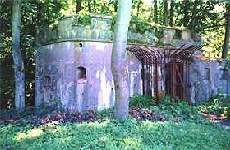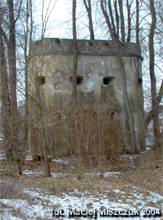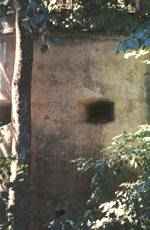 In planning for war before 1914 (project of General Staff from 1898), Germany did not foresee any aggressive moves against Russia in first phase of European conflict. Only 12% of the military strength were located here, intended for the defence of the eastern border. In place of higher concentrations of troops (already forecasted to be required on the Western Front), temporary defences were to be in the form of various fortifications and hinderances. The main centres of defence in this region were the group of fortresses in the Thorn (Torun) - Culm (Chelmno) - Graudenz (Grudziadz) - Marienburg (Malbork) - Dirschau (Tczew) and Danzig (Gdansk) regions. It was the so-called "Vistula Line" (Weichsellinie). Also included in the defensive plan was the already obsolete Fortress "Boyen" in Loetzen (Gizycko) and the considerably more modern ring-fortress in Koenigsberg (Krolewiec). In 1898 Germany strengthened this system of fortifications, using convenient geographical features such as ridges, valleys, forests, swamps and lakes. To force Russian armies into dividing their power, Germany decided to fortify defiles between the Great Mazurian Lakes with channels, and the western bank of the Wegorapa River (Angerapp) and forests of Puszcza Piska (Johannisburger Heide). Movement of the enemy's army would than become more difficult with the boggy valley of the Pregola River (with numerous inflows) and with thick forests. Because of the temporariness of these defences it determined that these fortifications were to be weakly built. This system of defence was named the Position Loewentin-Talter line (from names of lakes), and later the Mazurian Lakes Position (MLP) - Masurische Seenstellung. In the south, the German Army lengthened it fortifications at the Forest Position Szczytno (Ortelsburger Waldstellung), and also on the north Wegorapa River Position (Angerappstellung). Most of the important fortified modifications were made between 1900-1905.
In planning for war before 1914 (project of General Staff from 1898), Germany did not foresee any aggressive moves against Russia in first phase of European conflict. Only 12% of the military strength were located here, intended for the defence of the eastern border. In place of higher concentrations of troops (already forecasted to be required on the Western Front), temporary defences were to be in the form of various fortifications and hinderances. The main centres of defence in this region were the group of fortresses in the Thorn (Torun) - Culm (Chelmno) - Graudenz (Grudziadz) - Marienburg (Malbork) - Dirschau (Tczew) and Danzig (Gdansk) regions. It was the so-called "Vistula Line" (Weichsellinie). Also included in the defensive plan was the already obsolete Fortress "Boyen" in Loetzen (Gizycko) and the considerably more modern ring-fortress in Koenigsberg (Krolewiec). In 1898 Germany strengthened this system of fortifications, using convenient geographical features such as ridges, valleys, forests, swamps and lakes. To force Russian armies into dividing their power, Germany decided to fortify defiles between the Great Mazurian Lakes with channels, and the western bank of the Wegorapa River (Angerapp) and forests of Puszcza Piska (Johannisburger Heide). Movement of the enemy's army would than become more difficult with the boggy valley of the Pregola River (with numerous inflows) and with thick forests. Because of the temporariness of these defences it determined that these fortifications were to be weakly built. This system of defence was named the Position Loewentin-Talter line (from names of lakes), and later the Mazurian Lakes Position (MLP) - Masurische Seenstellung. In the south, the German Army lengthened it fortifications at the Forest Position Szczytno (Ortelsburger Waldstellung), and also on the north Wegorapa River Position (Angerappstellung). Most of the important fortified modifications were made between 1900-1905. The key - points of the defence of MLP were the Ruciane Nida (Niedersee), Guzianka, Mikolajki (Nikolaiken), Skorupki, Zielonu Gaj, Szymonka (Schimonken),
 Kula and the Fortress Boyen on "Gizycko Island" (Inselgelaende) [Map]. The standard features common to these points were the small "forts of infantry" (Infanteriewerke), trapezium-shaped terrestrial fortifications with central shelters providing protecting from artillery fire. Walls, built from brick or concrete were 80-100 cm thick, with reinforced concrete ceilings, 10- 20 cm thick, covered with earthen ramparts were common. These forts supplemented the sand or concrete open HMG (heavy machine gun) stands. These fortifications were strong points protecting 1-2 companies of infantry. For support, the German Army used artillery battery stands reinforced with armour-plated turrets for the 53mm guns (Fahrbare Panzerlafette 5,3cm). From 1905 onwards, the German Army constructed concrete (1-1,5m thick walls) HMG-towers (MG-Turm), three in Ruciane & Guzianka (for defence of bridges and canals) and two near the bridge at Mikolajki. Later, at this town near the new railway bridge, twoblockhouses were added. The German Army extended their fortifications, especially near Gizycko. As well, a dozen new shelters were constructed for infantry, artillery-man, ammunition storage, and observation around old Fortress Boyen.
Kula and the Fortress Boyen on "Gizycko Island" (Inselgelaende) [Map]. The standard features common to these points were the small "forts of infantry" (Infanteriewerke), trapezium-shaped terrestrial fortifications with central shelters providing protecting from artillery fire. Walls, built from brick or concrete were 80-100 cm thick, with reinforced concrete ceilings, 10- 20 cm thick, covered with earthen ramparts were common. These forts supplemented the sand or concrete open HMG (heavy machine gun) stands. These fortifications were strong points protecting 1-2 companies of infantry. For support, the German Army used artillery battery stands reinforced with armour-plated turrets for the 53mm guns (Fahrbare Panzerlafette 5,3cm). From 1905 onwards, the German Army constructed concrete (1-1,5m thick walls) HMG-towers (MG-Turm), three in Ruciane & Guzianka (for defence of bridges and canals) and two near the bridge at Mikolajki. Later, at this town near the new railway bridge, twoblockhouses were added. The German Army extended their fortifications, especially near Gizycko. As well, a dozen new shelters were constructed for infantry, artillery-man, ammunition storage, and observation around old Fortress Boyen.
The Russian Army did not plan a frontal attack on the MLP, as they recognized this area from the Battle of 26 VIII 1914. Their primary thrust was an encirclement of this position from the west and
 the north through Ketrzyn (Rastenburg), Ryn (Rhein) and Gumbin (Gumbinnen - today Gusiew). This manoeuvre was not successful for the Russians as it lead to the disaster known as the "Battle of Tannenberg". The defence line, MLP, was used once again when German forces retreated in the autumn of 1914. After the Battle in sector Cierzpiety - Tyrklo, the German Army stopped the Russians near MLP-line near Rydzewo, Paprotki, Woznice and Luknajno (near Mikolajki). Similar, but less intensive fighting ocurred in the winter of 1914/15 around Ruciane-Nida, where the Battle ended with the Russian Siberian Corps being destroyed. It was last Battle in Eastern Prussia in IWW, known as the "Second Battle between the Mazurian Lakes" or the "Winter-Battle".
the north through Ketrzyn (Rastenburg), Ryn (Rhein) and Gumbin (Gumbinnen - today Gusiew). This manoeuvre was not successful for the Russians as it lead to the disaster known as the "Battle of Tannenberg". The defence line, MLP, was used once again when German forces retreated in the autumn of 1914. After the Battle in sector Cierzpiety - Tyrklo, the German Army stopped the Russians near MLP-line near Rydzewo, Paprotki, Woznice and Luknajno (near Mikolajki). Similar, but less intensive fighting ocurred in the winter of 1914/15 around Ruciane-Nida, where the Battle ended with the Russian Siberian Corps being destroyed. It was last Battle in Eastern Prussia in IWW, known as the "Second Battle between the Mazurian Lakes" or the "Winter-Battle".
In the interwar - period, Germany gave up further development of MLP idea. Only in the region of Ruciane-Nida, in 1928, were four new shelters for infantry built (Gruppenunterstand), thereby strengthening the old Infrantreiwerke. Fortifications in section Mikolajki-Gizycko, were renewed in 1944, as a reserve internal line of GFR (Gizycko Fortified Region) defence. Like other fortifications of the Great Lakes, the MLP was abandonned in January 1945 without a fight.

